IHT specification
Strong heart disease
- High blood pressure
- Ischemic heart disease
Metabolic disorder
- Obesity
- Metabolic syndrome
Other Apps
- Recovery from myocardial infarction and heart surgery
- Chronic heart failure (Ongoing)
ReOxy is a new respiratory therapy device, intended for patients with reduced concentrations of mixed oxygen (hypoxemia) during treatment.
The primary goal when using a ReOxy device is an appropriate short- and long-term adaptive response at the system, organ, tissue, and cellular levels. These compensatory adaptive mechanisms have been scientifically proven to be effective in the treatment of cardiovascular and metabolic diseases.
ReOxy uses Self-Regulating Therapy (SRT®) technology. SRT technology is based on the principle of biological response, where the patient’s body’s response determines the treatment parameters and controls them throughout the entire course of treatment.

SRT uses state-of-the-art software that can read the analytical results from the built-in pulse oximeter to adjust the oxygen delivery mix and the time it takes for each patient to respond to changes in indicators. vital numbers, i.e. blood oxygen saturation (Sp02) and heart rate.
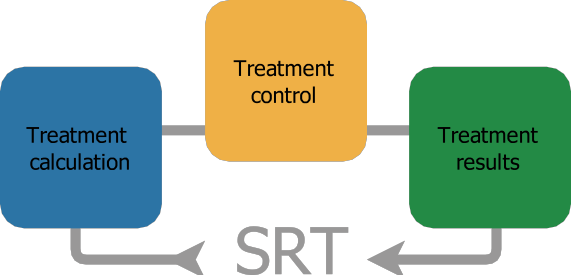
Using advanced SRT technology allows:
• Pre-treatment testing – to assess optimally effective treatment areas and to calculate individual treatment parameters;
• Treatment – to “keep” the patient in the optimal therapeutic effect zone by adjusting treatment parameters in response to changes in the patient’s state
• After treatment – calculate and save treatment parameters for the next treatment session.
• Treatment of hypoxemia in “Hypoxemia – Hyperoxia” (IHHT) based on SRT technology
• Pre-adaptation to hypoxemia
Intermittent hypoxia (IHT) consists of short-term episodes of hypoxemia (9-15% O2), interspersed by short periods of recovery. These periods of recovery may have normal oxygen levels (21% O2, hypoxic–normal hypoxic pattern), or hyperoxia (30-35% O2, Hypoxemia – Hyperoxia). The typical course of treatment consists of 10-15 sessions

Hypoxic preadaptation (HP) i.e. exposure of the body, its systems, organs, tissues or cells to the regulation of hypoxemia increases resistance to the attack. subsequent severe hypoxemia. It mobilizes genomic evolution believed to be the body’s resistance mechanisms.
This process involves the activation of many intracellular components, including receptors, the mitochondrial respiratory chain, major intracellular regulatory systems, early genes, and superfamilies of transcription factors. activation and induction encoding (T.Serebrovskaya 2014).
Notable protective effects of HP: Rapid protective effect (early HP), when hypoxemia and oxygen recovery follow immediately by increasing tolerance to the condition hypoxemia and a slow (late) HP effect, when an increase in the resistance of organs and tissues to hypoxia is seen 16-24 h after hypoxemia/restored oxygen [17 , 18, 22, 26].
• Long-term antihypertensive effect [1, 2, 9, 19, 23, 24, 29] IHT helps to reduce blood pressure, improve the patient’s health status and physical performance, and normalize O2 consumption and transport. The antihypertensive effect persisted for 6 months in 80% of patients and 1 year in 43% of patients. 79% of patients were able to stop taking the drug after IHT. No adverse effects were noted [19].
• Increase the ability to work and practice [1, 7, 8, 9, 11, 15, 16, 17, 21,29] Poor exercise capacity increases mortality in patients with coronary artery disease (CAD) and chronic obstructive pulmonary disease (COPD). The process of abstinence from hypoxemia may be a valuable preventive and therapeutic measure in these patients [4].
• Increases myocardial tolerance to hypoxia
blood/ischemia (cardioprotective and antianginal effects)
IHT has strong antianginal efficacy in patients with ischemic heart disease. These effects persisted 3 months after IHT treatment in 88% of patients and 6 months in 80% of patients [6,9, 19].
• Increased myocardial vasculature, increased coronary blood flow (angiogenesis – development of collateral capillaries, endothelium-dependent vasodilation) [3, 33, 35]
• Effects on Metabolism: Moderate IH regimens are recognized to be effective for metabolism, including weight loss, hypoglycemia, and
cholesterol and insulin sensitivity [25].
– Normalize cholesterol levels, reduce LDL and
triglycerides, increased HDL [5, 7, 9, 13, 14, 20, 27,31]
– The effect of lowering blood sugar [5, 7, 31]
– Enhance weight loss [11, 12, 32]
– Limiting appetite [32,34]
• Other effects:
– Significantly improved quality of life[30] – Improves short-term memory and cognitive ability [30] – Reduce endothelial damage and disorders [10]
IHT specification
Strong heart disease
Metabolic disorder
Other Apps
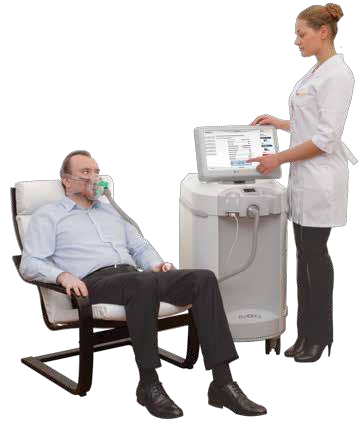
• Treatment parameters for hypoxemia-hyperoxygenation were determined after a preliminary assessment of adequacy of the hypoxic gas mixture, by performing a hypoxemia test.
p>
• Built-in intelligent software automatically identifies and suggests key treatment parameters for a personalized treatment program, initially based on test results
hypoxemia state. Intensity of treatment parameters varies within preset limits in every procedure.
• At the end of each test, procedure and treatment, ReOxy generates a pdf summary report.
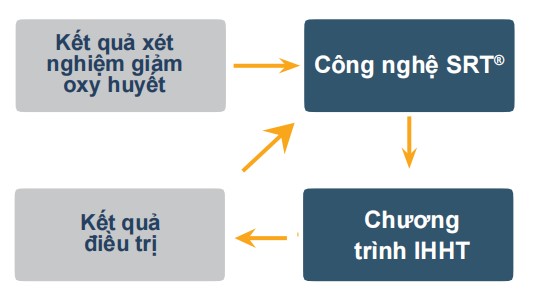
• Hypoxia test
Assess each patient’s tolerance to hypoxia and determine parameters for further treatment procedures.
• Analyze test results automatically
• Automatic calculation of patient response parameters
Color Control Screen
• Wide viewing angle and high contrast
• Show status (hyperoxygenation / hypoxemia)
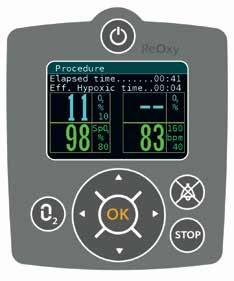
Benefits of ReOxy
• More than 10 years of research in clinical applications
IHT
• SRT Technology: Individual Treatment Program and Control
• Proprietary software algorithms included
• Hypoxemia – hyperoxia: a regulatory factor
Improved treatment reduces side effects • Fully automated process, easy to operate
• Oxygen concentration meter in the circuit to control the information
number of treatments in real time • Patient safety (multi-level control, alerts
physiology and engineering)
• Durable, movable, independent (no room needed
own equipment)
• Individually programmed operating model
• Monitor heart rate and blood oxygen saturation level
• Maintain patient database, extract data and analyze statistics
• Possibility to update the included software
ReOxy Button
• Manual airflow conversion
Mix and supply gas mixture
• Gas mixture supplied:
– Decreased blood oxygen (10-14% O2)
– Increased blood oxygen (30-40% O2)
• Automatic gas flow switching (SRT technology)
• Automatic flow volume control
Multi-level safety system
• Automatically identify the optimal treatment effect area
• Automatically switch between air flows when maximum and minimum threshold values are reached
• Manual airflow conversion
• Integrated safety valve (automatically supplies gas at the
surrounding school)
• Audio and visual warning signals

• Simple, user-friendly interface
• Data extraction: medical records and technical records
• Securely mount in the most convenient position
• Accurate reading and fast signal processing
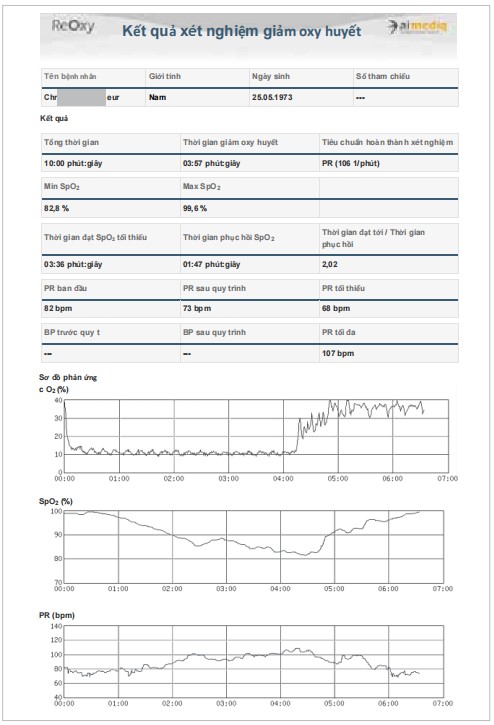
Trends
cO2 – Oxygen concentration supplied to the patient through the mask.
SpO2 – SpO2 response to the change of O2 concentration
PR – Pulse rate response to changes in O2 concentration
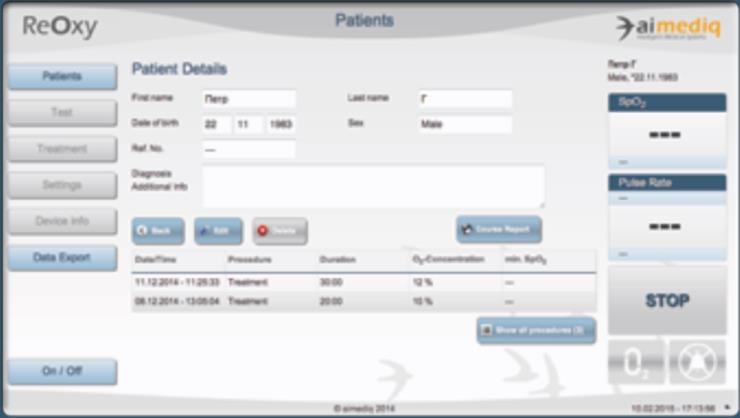
Select and fill patient information into the patient and process database management system.
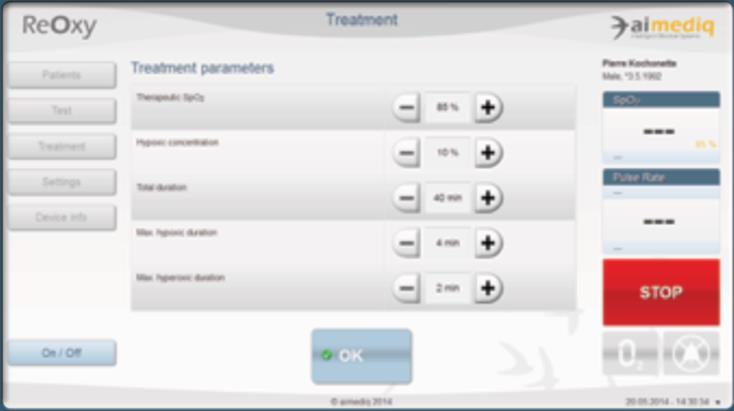
Confirm calculated process parameters and alarm limits. Wear sensor and mask.
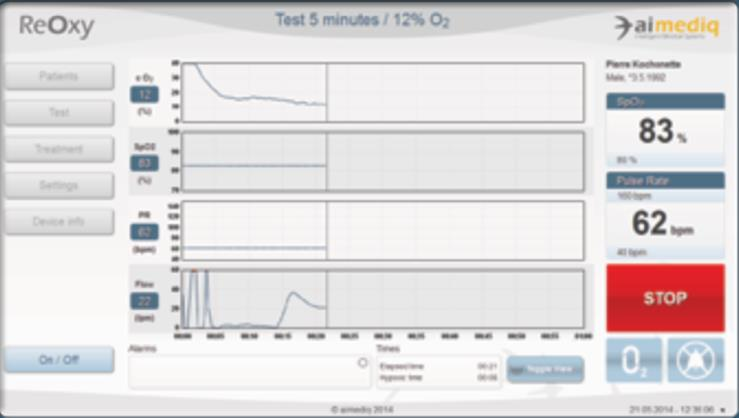
During the process, ReOxy monitors SpO2, PR and O2 values. The procedure takes 30-60 minutes.
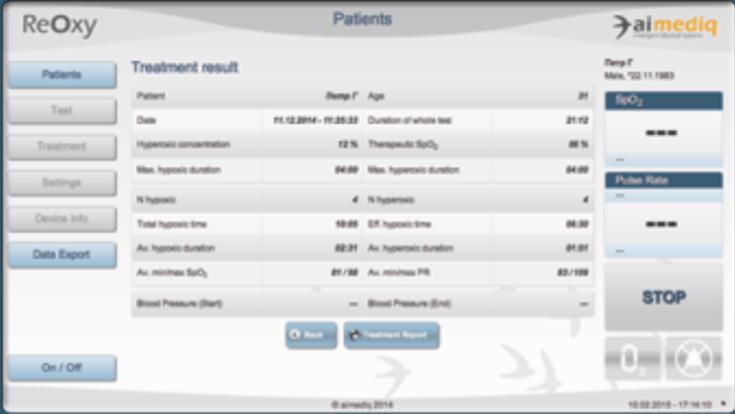
Remove mask and sensor. Review automatically generated process reports.

Adaptation to low oxygen concentrations (hypoxia) in cells and tissues leads to transcriptional induction of genes involved in angiogenesis, iron metabolism, glucose metabolism and proliferation/survival of cell. The underlying factor regulating this response is hypoxia-inducible factor-1 (HIF-1), an activator of oxygen-inducible transcription [18].
Ischemic diseases such as stroke and heart attack due to hypoxemia are caused by cerebral ischemia and myocardial ischemia. Increased vascular endothelial growth factor (VEGF) by HIF-1 or HIF-2 can lead to the formation of new blood vessels of the target region in the brain.
and heart, thereby providing additional blood flow and oxygen and reducing adverse reactions to ischemia [28].
Restored endothelial function and increased nitric oxide synthesis [19], as well as enhanced tolerance to HIF-1-mediated hypoxemia of the myocardium are involved mechanisms. Along with decreased heart rate observed in both healthy and elderly patients, and related metabolic effects
important (such as lowering LDL, triglycerides, and cholesterol) [4, 29],
These changes contribute to a decrease in the frequency of angina.
The antihypertensive mechanism of IHT includes hypoxic stimulation of endothelial NO production, leading to vasodilation and reversible capillary opening [26].
Safety
No patient has ever had to drop out of a study due to adverse events in all studies known to the manufacturer.
Mild adverse events observed in these studies, such as dizziness, sedation, dyspnoea, or transient hypertension, were observed in only a few patients. The negative feelings and side effects go away after a slight increase in O2.
Short-term hypoxic episodes, which do not cause angina in IHD patients with a history of MI, are generally well tolerated even in the elderly (65 to 75 years of age) [29].
To date, no significant adverse effects have been reported for the hypoxemia-hyperoxia combination [8, 9].
It should be noted that both hypoxic-
Hyperoxia using ReOxy.
A risk analysis was performed for patients with CVD who did not develop a serious adverse event due to the ReOxy device during use. The following non-serious device-related adverse events have been reported:
• 6 cases of chest tightness during the procedure without ECG deviation in 584 procedures resolved spontaneously [8],
• 4 cases of mild headache and 2 cases of mild dizziness resolved spontaneously in 584 procedures [8],
• Transient mildly above-normal hypertension occurred in 1 out of 35 patients in a published study [29],
The transient increase in mean heart rate from baseline during IHT is an adaptive response to hypoxemia.
| Model | 60-1001 | 60-2001 |
|---|---|---|
| O2 concentration, hypoxic gas mixture | 10-14% | 10-14% |
| O2 concentration, hyperoxic gas mixture | 30-40% | 30-40% |
| Capacity | Not more than 25 liters/minute | Not more than 25 liters/minute |
| Airflow Conversion | – Automatic SRT – Manual Style | – Automatic SRT – Manual Style |
| Duration of treatment | 30-60 minutes | 30-60 minutes |
| Tracking parameters | Circuit, SpO2, O2 | Circuit, SpO2, O2 |
| SpO2 Limit | 1-100% | 1-100% |
| Accuracy of SpO2 Assessment | 70-100% +/-2%, 0-69% +/-3% | 70-100% +/-2%, 0-69% +/-3% |
| Heart rate limit and accuracy | 25-240 +/-3% | 25-240 +/-3% |
| EU standard oxygen meter | EN 60601-1,EN60601-1-4,EN865,EN475 | EN 60601-1,EN60601-1-4,EN865,EN475 |
| Warning Signal | SpO2, HR, sensor, power supply (Warning by sound and image) | SpO2, HR, sensor, power supply (Warning by sound and image) |
| Data Interface | – 6” color multifunction monitor included | – 6” color multifunction display included – 15” color touch screen |
| Save and extract data | Not applicable | – Internal Memory – USB port |
| Outlet pressure | < 2 kPa | < 2 kPa |
| Noise intensity | < 50 dB | < 50 dB |
| Dimensions (H L х W) | 90 70 50 cm | 120 70 50 cm |
| Weight | 38 kg | 44 kg |
| Voltage | 230 V / 50 Hz | 230 V / 50 Hz |
| Electricity Consumption | 450 VA | 540 VA |
| Warranty | 2 years | 2 years |
| Patient-specific kits | Special breathing ring (2 sizes) | Special breathing ring (2 sizes) |
| Standard | ReOxy60-10001, patient kit, pulse oximeter, sensor | ReOxy60-10001, patient kit, pulse oximeter, sensor |